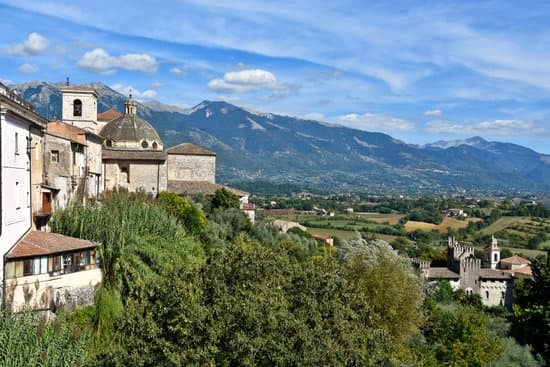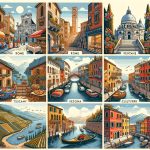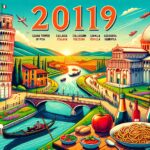Italy, with its enchanting beauty and rich history, is an absolute must-visit destination for travelers seeking a unique and fulfilling experience. From the picturesque coastline of the Amalfi Coast to the iconic landmarks like the Colosseum and Vatican City, Italy offers a diverse range of attractions that cater to every traveler’s interest.
To make the most of your Italian adventure, a well-crafted travel guide is essential in navigating through the country’s vibrant regions and uncovering their hidden gems.
When it comes to exploring Italy, there is something for everyone. Whether you are drawn to the mesmerizing art and architecture of Florence and Venice or captivated by the charm of Cinque Terre and its colorful cliffside villages, each region has its own unique cultural offerings waiting to be discovered.
A well-curated travel guide can help you identify must-see destinations to include in your itinerary and ensure that you don’t miss out on any remarkable experiences along the way.
In addition to showcasing Italy’s top attractions, a comprehensive travel guide also emphasizes the importance of understanding Italy’s seasons, weather conditions, and vibrant festivals held throughout the year. By discovering the ideal time to visit based on your preferences, you can make informed decisions about when to plan your trip. Whether you prefer sunny beach days or festive city celebrations, there is no shortage of opportunities to immerse yourself in Italian culture during your stay.
Embarking on an Italian adventure can be both thrilling and overwhelming. With a vast transportation system that includes trains, buses, and rental cars, navigating from one city or region to another requires careful planning. Fortunately, a reliable travel guide can unravel the intricacies of Italy’s transportation system while providing vital tips and tricks for hassle-free travel between cities.
Ultimately, Italy offers an endless array of experiences just waiting to be discovered. By delving into well-crafted travel guides tailored specifically for this captivating country, you can uncover hidden gems, savor local cuisine, embrace Italian culture and etiquette, budget effectively, and create cherished memories that will last a lifetime.
So, whether you’re a first-time visitor or a seasoned traveler to Italy, let the travel guides be your reliable companion in unlocking the true beauty of this must-visit destination.
Understanding Italy’s Lure
Italy is a country that is teeming with awe-inspiring attractions and landmarks that have captivated travelers for centuries. From ancient ruins to stunning art collections, Italy offers something for every type of traveler. In this section, we will explore some of the top attractions and landmarks that make Italy a must-visit destination.
Iconic Landmarks
One cannot discuss Italy’s top attractions without mentioning its iconic landmarks. The Colosseum in Rome stands as a testament to the grandeur and power of the ancient Roman Empire. Its magnificent architecture and rich history continue to fascinate visitors from around the world. Vatican City, with its majestic St. Peter’s Basilica and the Sistine Chapel adorned with Michelangelo’s masterpiece, is another must-see destination in Rome.
Moving north to Pisa, the Leaning Tower of Pisa continues to defy gravity and astound visitors with its unique tilt. This architectural marvel draws crowds who want to witness its enchanting beauty firsthand.
Artistic Gems
For art enthusiasts, Florence and Venice are two cities not to be missed. Florence, birthplace of the Renaissance, boasts world-renowned art galleries such as the Uffizi Gallery and the Accademia Gallery, where you can marvel at famous works by artists like Botticelli, Michelangelo, and Leonardo da Vinci. In Venice, you’ll find an abundance of breathtaking architecture and masterpieces in every corner – from St. Mark’s Basilica to the Doge’s Palace.
Natural Beauty
Italy isn’t just known for its historical sites; it also boasts stunning natural landscapes. The Amalfi Coast is famous for its picturesque cliffside towns overlooking turquoise waters. Visitors can take scenic drives along winding coastal roads or relax on beautiful beaches dotted along the coast. Another natural gem is Cinque Terre, a collection of colorful fishing villages nestled on the rugged Italian Riviera. With its charming atmosphere and stunning views, Cinque Terre is truly a hidden gem.
When planning your trip to Italy, make sure to include these top attractions and landmarks in your itinerary. Each one offers a unique and unforgettable experience that will leave you with cherished memories of your visit to Italy.
The Best Time to Visit Italy
Italy is a country known for its beautiful landscapes, rich history, and vibrant culture. However, to truly experience the beauty of Italy, it’s important to choose the right time to visit. The weather conditions and festivals can greatly impact your travel experience. This section will guide you through understanding the best time to visit Italy based on weather and festivals.
Weather plays a crucial role in planning your trip to Italy. The country experiences a Mediterranean climate, characterized by hot summers and mild winters. However, there are regional variations in weather patterns, so it’s important to consider the specific regions you plan to visit.
In general, the best time to visit Italy is during spring (April-May) and fall (September-October). These seasons offer pleasant temperatures, lower tourist crowds, and picturesque landscapes. Spring brings blooming flowers and greenery, while autumn offers colorful foliage that enhances the beauty of Italian cities and countryside.
| City | Spring Average Temperature | Fall Average Temperature |
|---|---|---|
| Rome | 17°C – 23°C (63°F – 73°F) | 13°C – 23°C (55°F – 73°F) |
| Florence | 14°C – 20°C (57°F – 68°F) | 11°C – 20°C (52°F – 68°F) |
| Venice | 10°C – 17°C (50°F – 63°F) | 9°C – 17°C (48°F – 63°F) |
| Naples | 16°C – 20°C (61°F – 68°F) | 15°C – 25°C (59°F – 77°F) |
Aside from the weather, festivals and events are an integral part of Italian culture. They offer a unique insight into the traditions and customs of the country. Some of the most popular festivals in Italy include:
- Carnival in Venice: Held in February, this flamboyant festival showcases elaborate costumes, masks, and parades.
- Easter: Celebrated throughout Italy with religious processions, feasts, and special events.
- La Biennale di Venezia: Held every two years in Venice, this renowned art exhibition showcases contemporary works from around the world.
- Palio di Siena: Held twice a year in July and August, this historic horse race takes place in the city’s central Piazza del Campo.
These are just a few examples of the many festivals held throughout Italy. Make sure to check the local calendar when planning your trip to coincide with any events that interest you.
By considering both weather conditions and festival schedules, you can ensure that your visit to Italy is memorable and aligns with your preferences. Whether you’re exploring ancient ruins or immersing yourself in local traditions during festivals, Italy has something to offer all year round.
Navigating Italy’s Transportation System
Italy offers a comprehensive transportation system that allows travelers to easily navigate the country and explore its various regions. Whether you prefer the convenience of trains, buses, or rental cars, there are plenty of options to suit your needs. However, understanding the intricacies of Italy’s transportation system can be a little overwhelming for first-time visitors. That’s why it’s important to arm yourself with some essential tips and tricks to ensure a hassle-free travel experience.
Comparing the Modes of Transportation
- Trains: Italy has an extensive train network that connects major cities and smaller towns. Traveling by train is generally considered one of the most convenient and efficient ways to get around. The high-speed trains, such as Trenitalia’s Frecciarossa and Italo, offer comfortable travel experiences between popular tourist destinations. It is recommended to book your tickets in advance, especially during peak travel seasons.
- Buses: In addition to trains, buses also play a significant role in Italy’s transportation system. They are often the preferred mode of transport for shorter distances or more remote areas not serviced by trains. Companies like FlixBus and Marino offer affordable bus options that connect various cities within Italy and even neighboring countries.
- Rental Cars: Renting a car gives you the freedom to explore Italy at your own pace and venture into smaller towns or rural areas that may not have extensive public transportation options. However, driving in larger cities like Rome or Florence can be challenging due to congestion and limited parking spaces. If you decide to rent a car, research local driving rules and consider parking facilities when planning your itinerary.
Essential Tips for Smooth Travel
- Validate Your Tickets: When traveling on regional trains or buses, it’s crucial to validate your ticket before boarding. Failure to do so could result in hefty fines if caught by ticket inspectors during your journey.
- Avoid Rush Hour: If possible, try to plan your travel outside of peak commuting hours. Rush hour in Italy typically occurs between 8:00 am – 9:00 am and 5:00 pm – 7:00 pm. This will not only help you avoid overcrowded trains or buses but also save you time.
- Check the Timetable: Always double-check train or bus schedules before heading to the station as they can be subject to last-minute changes. Websites like Trenitalia and Rome2rio are excellent resources for finding up-to-date information on routes and departure times.
By familiarizing yourself with these tips and tricks, you’ll be well-equipped to navigate Italy’s transportation system and enjoy a seamless travel experience across this captivating country. Whether you’re exploring ancient ruins in Rome, cruising along the Amalfi Coast, or wandering through quaint Tuscan villages, Italy’s transportation system ensures easy access to all its remarkable attractions.
Finding the Perfect Accommodation
One of the most crucial aspects of planning a trip to Italy is finding the perfect accommodation that suits your needs and preferences. Italy offers a wide range of options, including hotels, bed and breakfasts (B&Bs), and agriturismos, each with its own unique charm and benefits. Understanding these different types of accommodations will help you make an informed decision that enhances your overall experience in Italy.
Hotels are a common choice for travelers due to their convenience and amenities. From luxurious five-star hotels to budget-friendly options, Italy has a vast selection of hotels to cater to various budgets and preferences. Choosing a hotel in a central location allows easy access to popular attractions and public transportation. Additionally, many hotels offer additional services such as concierge assistance, on-site restaurants, spa facilities, and organized tours.
For those seeking a more intimate experience and local immersion, bed and breakfasts (B&Bs) are an excellent option. B&Bs provide a cozy atmosphere with personalized service from the owners who often double as guides or locals willing to share insider tips. They offer comfortable rooms with breakfast included in the price. Staying at a B&B can provide an opportunity to interact with other travelers and exchange recommendations for exploring the surrounding area.
If you’re looking for a truly unique Italian experience amidst nature and traditional agricultural practices, consider staying at an agriturismo. Agriturismos are farm stays that offer rustic accommodations in rural areas, allowing visitors to unwind in serene surroundings while enjoying locally-produced food and wine.
Whether it’s vineyards in Tuscany or olive groves in Sicily, agriturismos provide an authentic glimpse into traditional Italian farming life with opportunities for activities like wine tasting or cooking classes using fresh ingredients sourced from the farm.
When planning accommodation for your Italian adventure, consider factors such as location, budget, amenities, and the experience you desire. With a wide variety of options ranging from hotels to B&Bs and agriturismos, there is something to suit every traveler’s taste. Researching and reading reviews in advance can help ensure that you find the perfect accommodation that complements your overall travel experience in Italy.
Savoring Italian Cuisine
When it comes to Italy, one cannot ignore the allure of its delectable cuisine. Italian food is renowned worldwide for its simplicity, fresh ingredients, and incredible flavors. From pasta to pizza, gelato to espresso, Italy is a paradise for food lovers. In this section, we will delve into the world-renowned gastronomic delights of Italy and explore some must-try dishes and culinary experiences.
Exploring Regional Specialties and Traditional Dishes
Italy’s rich culinary heritage is deeply rooted in regional specialties and traditional dishes that vary from north to south. Each region showcases unique flavors and ingredients that represent their cultural identity. For instance, in the northern regions like Lombardy and Piedmont, you can savor mouthwatering risottos, polentas, and hearty meat dishes. The central regions such as Tuscany and Emilia-Romagna are famous for their pasta dishes like lasagna, tagliatelle al ragù (Bolognese sauce), and pappardelle with wild boar sauce.
As you move further south to regions like Campania and Sicily, you’ll discover seafood delicacies like spaghetti alle vongole (clams), frutti di mare (mixed seafood), and arancini (fried stuffed rice balls). Sicilian cuisine also boasts unique flavors influenced by Arab, Greek, Spanish, and Norman cultures. Don’t forget to try the iconic street food of Naples – pizza. Whether you prefer the classic margherita or want to experiment with different toppings, there’s a pizza for everyone in Italy.
Recommending Food Tours and Cooking Classes
To truly immerse yourself in the Italian food culture, consider joining a food tour or taking a cooking class. Food tours offer an opportunity to taste a variety of local specialties while learning about their history from knowledgeable guides. You can explore bustling markets, family-run trattorias, and hidden culinary gems that may not be mentioned in traditional travel guides.
Cooking classes provide hands-on experiences where you can learn how to prepare authentic Italian dishes from local chefs or home-cooks. From making pasta dough from scratch to creating the perfect tiramisu, these classes offer insights into traditional cooking techniques and secret family recipes. It’s a great way to bring a piece of Italy back home with you and impress your friends with your newfound culinary skills.
Italy is a gastronomic paradise that promises unforgettable taste sensations. Exploring the regional specialties, joining food tours, and participating in cooking classes will undoubtedly enhance your travel experience and allow you to savor the true essence of Italian cuisine. So make sure to indulge in the flavors of Italy during your visit – it’s an experience you won’t want to miss.
Embracing Italian Culture & Etiquette
Italy is not just a country known for its stunning landscapes and famous landmarks, but also for its rich cultural heritage and unique customs. To truly immerse oneself in the Italian experience, it is essential to embrace the local culture and observe proper etiquette. From greetings to table manners, understanding and respecting Italian customs can greatly enhance your travel experience in this beautiful country.
Cultural Heritage
Italy boasts a long and fascinating history, with influences from ancient civilizations like the Romans and Greeks, as well as Renaissance art and architecture. To truly appreciate Italy’s cultural heritage, taking the time to visit museums, historical sites, and art galleries is a must. Whether it’s admiring Michelangelo’s masterpieces at the Sistine Chapel or exploring the ruins of Pompeii, these experiences offer a deeper understanding of Italy’s rich history.
Etiquette and Customs
Italian culture places great importance on politeness and respect for others. One important aspect of Italian etiquette is greeting people properly. While handshakes are common in formal settings, Italians often greet each other with a kiss on both cheeks (starting with the left). It’s important to note that these kisses are more symbolic than intimate gestures.
When it comes to dining out in Italy, there are certain customs to keep in mind. For instance, it is considered polite to wait until everyone has been served before beginning your meal. Additionally, remember to always use utensils when eating pasta or pizza – using your hands is seen as impolite.
Useful Phrases and Gestures
Learning a few basic Italian phrases can go a long way in showing respect for local customs. Simple greetings like “buongiorno” (good morning) or “buonasera” (good evening) can help break the ice and make interactions with locals more enjoyable.
It’s also worth noting that Italians have their own unique gestures. For instance, when saying “no,” Italians often tilt their head back slightly while raising their eyebrows. Similarly, to show confusion or frustration, they may raise both hands and shrug their shoulders. While not necessary to learn, recognizing these gestures can help you better understand the locals and appreciate the Italian way of communicating.
Embracing Italian culture and observing proper etiquette is not only a sign of respect but also an opportunity to connect with locals on a deeper level. By understanding and appreciating Italy’s customs, travelers can create memorable experiences that go beyond just visiting popular attractions.
Budgeting for an Italian Adventure
Italy is a dream destination for many travelers, but it can also be quite expensive. However, with careful planning and some money-saving tips and strategies, you can have an amazing Italian adventure without breaking the bank. In this section, we will explore some practical tips to help you budget for your trip to Italy and make the most of your travel experience.
One of the first steps in budgeting for your Italian adventure is determining how much money you are willing to spend on your trip. Consider factors such as accommodation, transportation, meals, activities, and any additional expenses like souvenirs or shopping. Create a detailed budget that outlines your estimated costs for each category so that you have a clear understanding of how much money you need to allocate for your trip.
When it comes to saving money on accommodation in Italy, consider alternatives to traditional hotels. Bed and Breakfasts (B&Bs) offer a more affordable option while still providing comfortable accommodations and personalized service. Another option is Agriturismos, which are farm stays where you can immerse yourself in the local culture and enjoy authentic experiences at a lower cost.
Transportation costs can also be a significant part of your budget. One of the best ways to save money on transportation in Italy is by taking advantage of the extensive public transportation system. Trains are often faster and more convenient than cars or buses when traveling between cities. It is also worth considering purchasing train passes or regional tickets if you plan on visiting multiple destinations.
Eating out at restaurants can quickly add up, so consider exploring local markets and grocery stores to purchase fresh produce and snacks for meals on-the-go. Additionally, trying street food or eating at local trattorias – small family-owned restaurants – can provide affordable yet delicious culinary experiences.
By prioritizing your expenditures and implementing these money-saving tips and strategies, you can enjoy an incredible Italian adventure without breaking the bank. Italy offers a wealth of beauty, culture, history, and cuisine that can be enjoyed on any budget. So start planning your trip to Italy today and get ready to create cherished memories that will last a lifetime.
| Money-Saving Tips | Strategies |
|---|---|
| Consider alternatives to traditional hotels like B&Bs and Agriturismos. | Create a detailed budget to allocate your expenses and determine how much money you need. |
| Take advantage of public transportation, such as trains, for cost-effective travel between cities. | Explore local markets and grocery stores for affordable meal options. |
| Prioritize your expenditures based on what is most important to you. | Try street food or eat at local trattorias for affordable yet delicious culinary experiences. |
Conclusion
Italy truly is a must-visit destination for travelers seeking enchanting beauty, rich history, and diverse cultural offerings. From iconic landmarks like the Colosseum and Vatican City to the mesmerizing art of Florence and Venice, Italy offers a plethora of attractions that leave visitors in awe. The picturesque Amalfi Coast and charming Cinque Terre further add to the allure of this beautiful country. With such an array of options, well-crafted travel guides are essential to ensure a fulfilling experience.
Finding the perfect time to visit Italy is crucial for enjoying its beauty to the fullest. Understanding the weather conditions and their impact on travel plans can make a significant difference in the overall experience. Additionally, Italy’s vibrant festivals throughout the year provide unique opportunities to immerse oneself in local culture and traditions.
Navigating Italy’s transportation system can be daunting for travelers, but with some tips and tricks, it can be made easier. Whether it’s choosing between trains, buses, or rental cars or learning how to travel hassle-free between cities and regions, having knowledge about Italy’s transportation system is key.
Accommodation plays a crucial role in creating cherished memories during an Italian adventure. Whether it’s staying at hotels, Bed and Breakfasts (B&Bs), or Agriturismos (farmhouses), each option offers its own charm and benefits. Choosing popular cities and regions for accommodation adds to the overall authentic experience.
No visit to Italy is complete without savoring its culinary delights. Exploring regional specialties and traditional dishes allows travelers to fully appreciate Italian cuisine. Engaging in food tours and cooking classes can elevate this experience by offering an immersive way to learn about Italy’s gastronomic culture.
Embracing Italian culture is essential for any traveler visiting this stunning country. Learning about local etiquette, customs, useful phrases, and gestures not only demonstrates respect but also enhances interactions with locals.
Budgeting plays a significant role in planning an Italian adventure. Practical tips and strategies can help travelers plan a cost-effective trip without compromising on experiences. Exploring alternative options to popular attractions and activities, as well as seeking out free or discounted experiences, ensures that every traveler can make the most of their budget.
In conclusion, Italy offers a unique blend of beauty, history, culture, and cuisine that creates cherished memories for every traveler. By delving into well-crafted travel guides, visitors can navigate this enchanting country with ease and make the most of their Italian adventure. So pack your bags, immerse yourself in the wonder of Italy, and create memories that will last a lifetime.
Frequently Asked Questions
Who are the best tour guides for Italy?
The best tour guides for Italy are typically knowledgeable locals who have a deep understanding and passion for the country’s history, culture, art, and cuisine. These guides often have years of experience leading tours and can provide valuable insights and anecdotes that enhance the overall experience.
It is important to find a guide who speaks fluent English and is able to cater to your specific interests and preferences, whether it be exploring ancient ruins in Rome or tasting wine in the Tuscan countryside.
What is the best month to travel to Italy?
Choosing the best month to travel to Italy greatly depends on personal preferences and what you want to experience during your trip. Generally, spring (April to June) and fall (September to October) are considered ideal as the weather is mild, tourist crowds are relatively lower compared to the peak summer months, and there is a high chance of enjoying pleasant outdoor activities without being overwhelmed by heat or long queues at popular attractions.
However, if you desire warm weather for beach trips and don’t mind larger crowds, summer (July and August) can also be a good option.
How much should an Italy trip cost?
The cost of an Italy trip can vary greatly depending on various factors such as accommodation choices, transportation expenses, dining preferences, activities planned, and the duration of your stay. On average, a basic budget for a week-long trip could range anywhere from $1500 to $3000 per person.
This would cover accommodation in mid-range hotels or vacation rentals, local transportation within cities using public transportation or taxis, meals at local restaurants (including some higher-end dining experiences), admission fees for popular attractions, and possibly some guided tours. Of course, luxury travelers can expect to spend more while budget-conscious travelers could spend less by opting for cheaper accommodations or prioritizing free activities.

I’m a passionate traveler, writer, and Italophile. My fascination with Italy’s history, art, and culture has led me on countless adventures across the Italian landscape. Through “I Live Italy,” I share my love for this extraordinary country and aims to inspire others to explore its boundless beauty.





